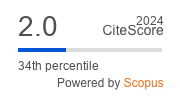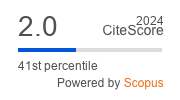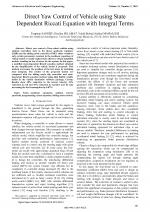| 2/2016 - 14 |
Direct Yaw Control of Vehicle using State Dependent Riccati Equation with Integral TermsSANDHU, F. |
| Extra paper information in |
| Click to see author's profile in |
| Download PDF |
Author keywords
nonlinear equations, optimal control, quadratic programming, ricatti equation, sliding mode control
References keywords
vehicle(33), control(33), system(18), dynamics(17), active(14), stability(9), steering(8), ling(7), integrated(6), systems(5)
Blue keywords are present in both the references section and the paper title.
About this article
Date of Publication: 2016-05-31
Volume 16, Issue 2, Year 2016, On page(s): 101 - 110
ISSN: 1582-7445, e-ISSN: 1844-7600
Digital Object Identifier: 10.4316/AECE.2016.02014
Web of Science Accession Number: 000376996100014
SCOPUS ID: 84974815457
Abstract
Direct yaw control of four-wheel vehicles using optimal controllers such as the linear quadratic regulator (LQR) and the sliding mode controller (SMC) either considers only certain parameters constant in the nonlinear equations of vehicle model or totally neglect their effects to obtain simplified models, resulting in loss of states for the system. In this paper, a modified state-dependent Ricatti equation method obtained by the simplification of the vehicle model is proposed. This method overcomes the problem of the lost states by including state integrals. The results of the proposed system are compared with the sliding mode slip controller and state-dependent Ricatti equation method using high fidelity vehicle model in the vehicle simulation software package, Carsim. Results show 38% reduction in the lateral velocity, 34% reduction in roll and 16% reduction in excessive yaw by only increasing the fuel consumption by 6.07%. |
| References | | | Cited By «-- Click to see who has cited this paper |
| [1] J. He, D.A. Crolla, M.C. Levesley and W.J. Manning, "Coordination of active steering, driveline and braking for Integrated vehicle Dynamics," Part D. Journal of Automobile Engineering, no.10, vol. 220, 2006. [CrossRef] [Web of Science Times Cited 135] [SCOPUS Times Cited 206] [2] M. K., Aripin, et al., "A Review of Active Yaw Control System for Vehicle Handling and Stability Enhancement," International Journal of Vehicular Technology, vol. 2014. [CrossRef] [SCOPUS Times Cited 82] [3] D. Li, S. Du, and F. Yu, "Integrated vehicle chassis control based on direct yaw moment, active steering and active stabilizer." Vehicle System Dynamics. vol. 46, no. S1, pp. 341-351, 2009. [CrossRef] [Web of Science Times Cited 84] [SCOPUS Times Cited 117] [4] S. C. Baslamisli, I. E. Kose and G. Anlac, "Handling stability improvement through robust active front steering and active differential control," Vehicle System Dynamics, vol. 49, no. 5, pp. 657-683, 2011. [CrossRef] [Web of Science Times Cited 45] [SCOPUS Times Cited 66] [5] M. Abe, N. Ohkubo, and Y. Kano, "A direct yaw moment control for improving limit performance of vehicle handling-comparison with 4WS," Vehicle System Dynamics, vol. 25, no. S1, pp. 3-23, 1996. [CrossRef] [Web of Science Times Cited 22] [SCOPUS Times Cited 32] [6] Y. Furukawa and M. Abe, "Advanced chassis control systems for vehicle handling and active safety," Vehicle System Dynamics. vol. 28, no. 2-3, pp. 59-86, 1997. [CrossRef] [Web of Science Times Cited 70] [SCOPUS Times Cited 109] [7] M. Nagai, "The perspective of research for enhancing active safety based on advanced control technology," Vehicle System Dynamics, vol. 45, no. 5, pp. 413-431, 2007. [CrossRef] [Web of Science Times Cited 25] [SCOPUS Times Cited 48] [8] F. Tahami, S. Farhangi and R. Kazemi, "A Fuzzy Logic Direct Yaw-Moment Control System for All-Wheel-Drive Electric Vehicles," Vehicle System Dynamics, no.41, vol.3, pp. 203-221, 2004. [CrossRef] [Web of Science Times Cited 97] [SCOPUS Times Cited 140] [9] B. L. Boada, M. J. L. Boada and V. Diaz, "Fuzzy Logic applied to yaw moment control for vehicle stability," Vehicle System Dynamics and Mobility, vol. 43, no. 10, pp. 753-770, 2005. [CrossRef] [Web of Science Times Cited 166] [SCOPUS Times Cited 224] [10] L. Junwei and Y. Huafang, "Fuzzy logic applied to yaw moment control for vehicle stability," in Mechatronics and Automation, 2009. ICMA2009. International Conference on IEEE 2009. [CrossRef] [SCOPUS Times Cited 5] [11] J. Wang and R. G. Longoria, "Coordinated and Reconfigurable vehicle dynamics control," Control System Technology, IEEE Transactions. vol. 17, no. 3, pp. 729-732, 2009. [CrossRef] [Web of Science Times Cited 223] [SCOPUS Times Cited 278] [12] N. Hamzah, M. K. Aripin, Y. M. Sam, H. Selamat, M. F. Ismail, "Vehicle Stability Enhancement based on second order sliding mode control.," Control System, Computing and Engineering, ICCSCE, 2012 IEEE International Conference pp. 580-585, 2012. [CrossRef] [SCOPUS Times Cited 9] [13] E. Ono, S. Hosoe., S. Doi., K. Asano., Y. Hayashi. "Theoratical Approach for improving the vehicle robust stability and maneuverabilityby active front wheel steering control." Vehicle System Dynamics, vol. 29, no. S1, pp. 748-753, 1998. [CrossRef] [Web of Science Times Cited 5] [SCOPUS Times Cited 6] [14] X. Yang, Z. Wang and W. Peng, "Coordinated Control of AFC and DYC for Vehicle handling and Stability Based on Optimal Guaranteed Cost Theory." Vehicle System Dynamics. vol. 47, no. 1, pp. 57-79, 2009. [CrossRef] [SCOPUS Times Cited 238] [15] X. Shen and F. Yu, "Investigation of Integrated Vehicle Chassis Control based on Vertical and Lateral Tyre behaviour correlativity," Vehicle System Dynamics, vol. 44, pp. 506-519, 2006. [CrossRef] [Web of Science Times Cited 21] [SCOPUS Times Cited 26] [16] T. Acarman, "Nonlinear optimal integrated vehicle control using individual braking torque and steering angle with online control allocation by using state dependent Riccati equation technique," Vehicle System Dynamics, vol. 47, no. 2, pp. 155-177, 2009. [CrossRef] [Web of Science Times Cited 43] [SCOPUS Times Cited 61] [17] B. A. Güvenç, T. Acarman and L. Guvenc, "Coordination of steering and individual wheel braking actuated vehicle yaw stability control," Intelligent Vehicle Symposium, 2003 Proceedings. IEEE. pp. 288-293, 2003. [CrossRef] [Web of Science Times Cited 45] [SCOPUS Times Cited 68] [18] F. Yu, D. F. Li and D. A. Crolla, "Integrated Vehicle Dynamics control-state-of-the art review", Vehicle Power and Propulsion Conference, 2008 VPPC'08 IEEE, IEEE, pp. 1-6, 2008. [CrossRef] [SCOPUS Times Cited 138] [19] W. Cho, J. Yoon, J. Kim, J. Hur and K. Yi, "An investigation into unified chassis control scheme for optimized vehicle stability and manoeuvrability," Vehicle System Dynamics. vol. 46, no. S1, pp. 87-105, 2008. [CrossRef] [Web of Science Times Cited 99] [SCOPUS Times Cited 139] [20] A. Elmarakbi, C. Rengaraj, A. Wheately and M. Elkady, "New integrated chassis control systems for vehicle handling performance enhancement,"International Journal of Dynamics and Control, vol. 1, no. 4, pp. 360-384, 2013. [CrossRef] [SCOPUS Times Cited 13] [21] J. S. Yu, "A robust adaptive wheel-slip controller for antilock brake system." Decision & control, 1997, Proceedings of the 36th IEEE Conference on. vol. 3, IEEE, 1997. [CrossRef] [22] J. Tjonnas and T. A. Johansen, "Stabilization of automotive vehicles using active steering and adaptive brake control allocation," Control Systems Technology, IEEE Transactions on. vol. 18, no. 3, pp.545-558, 2010. [CrossRef] [Web of Science Times Cited 198] [SCOPUS Times Cited 240] [23] S. Mammar and D. Koenig, "Vehicle Handling Improvement by Active Steering," Vehicle System Dynamics, vol. 38, no. 3, pp. 211-2 42,2002. [CrossRef] [Web of Science Times Cited 176] [SCOPUS Times Cited 237] [24] C. P. Mracek and J. R. Cloutier, "Control Designs for the nonlinear benchmark problem Via the State dependent Ricatti equation," Int. J. Robust Control, vol. 8, pp. 401-433, 1998. [CrossRef] [Web of Science Times Cited 264] [25] F. J. D'Amato and D. E. Viassolo, "Fuzzy control for active suspensions," Mechatronics, vol. 10, no. 8, pp. 897-920, 2000. [CrossRef] [Web of Science Times Cited 78] [SCOPUS Times Cited 117] [26] S. H. Zareh, A. Sarrafan, A. F. Jahromi, A. A. Khayat, "Linear quadratic gaussian application and clipped optimal algorithm using semi active vibration of passenger car," Mechatronics (ICM), 2011 IEEE International Conference on. IEEE, 2011. [CrossRef] [SCOPUS Times Cited 11] [27] P. F. Wu and C. F. Yung, "On the geometric and dynamic structures of the H2 optimal and H? central controllers." Automatica, vol.46, no.11, pp. 1824-1828, 2010. [CrossRef] [Web of Science Times Cited 5] [SCOPUS Times Cited 6] [28] R. E. Precup, M. B. Radac, M. L. Tomescu, E. M. Petriu and S. Preitl, "Stable and convergent iterative feedback tuning of fuzzy controllers for discrete-time SISO systems," Expert Systems with Applications , 2013, vol. 40, no.1, pp.188-199. [CrossRef] [Web of Science Times Cited 67] [SCOPUS Times Cited 76] [29] R. R. Yacoub, R. T. Bambang, A. Harsoyo and J. Sarwono, "DSP implementation of combined FIR-functional link neural network for active noise control," International Journal of Artificial Intelligence, vol. 12, no. 1, pp.36-47, 2014. [30] T. T. Wang, W. F. Xie, G. D. Liu and Y. M. Zhao, "Quasi Min-Max Model Predictive Control for Image Based Visual Servoing with Tensor Product Model Transformation," Asian Journal of Control, vol.17, no. 2, pp.402-416. 2015. [CrossRef] [Web of Science Times Cited 34] [SCOPUS Times Cited 39] [31] Fargham Sandhu, Hazlina Selamat, Yahaya MD Sam, "Linear Quadratic Regulator and Skyhook Application in Semiactive MR Damper Full Car Model," Asian Control Conference (ASCC), 2015 10th Asian IEEE, [CrossRef] [SCOPUS Times Cited 6] Web of Science® Citations for all references: 1,902 TCR SCOPUS® Citations for all references: 2,737 TCR Web of Science® Average Citations per reference: 59 ACR SCOPUS® Average Citations per reference: 86 ACR TCR = Total Citations for References / ACR = Average Citations per Reference We introduced in 2010 - for the first time in scientific publishing, the term "References Weight", as a quantitative indication of the quality ... Read more Citations for references updated on 2025-06-04 21:48 in 205 seconds. Note1: Web of Science® is a registered trademark of Clarivate Analytics. Note2: SCOPUS® is a registered trademark of Elsevier B.V. Disclaimer: All queries to the respective databases were made by using the DOI record of every reference (where available). Due to technical problems beyond our control, the information is not always accurate. Please use the CrossRef link to visit the respective publisher site. |
Faculty of Electrical Engineering and Computer Science
Stefan cel Mare University of Suceava, Romania
All rights reserved: Advances in Electrical and Computer Engineering is a registered trademark of the Stefan cel Mare University of Suceava. No part of this publication may be reproduced, stored in a retrieval system, photocopied, recorded or archived, without the written permission from the Editor. When authors submit their papers for publication, they agree that the copyright for their article be transferred to the Faculty of Electrical Engineering and Computer Science, Stefan cel Mare University of Suceava, Romania, if and only if the articles are accepted for publication. The copyright covers the exclusive rights to reproduce and distribute the article, including reprints and translations.
Permission for other use: The copyright owner's consent does not extend to copying for general distribution, for promotion, for creating new works, or for resale. Specific written permission must be obtained from the Editor for such copying. Direct linking to files hosted on this website is strictly prohibited.
Disclaimer: Whilst every effort is made by the publishers and editorial board to see that no inaccurate or misleading data, opinions or statements appear in this journal, they wish to make it clear that all information and opinions formulated in the articles, as well as linguistic accuracy, are the sole responsibility of the author.



